3 pkc+rsa
Download as pptx, pdf0 likes486 views
Public-key cryptography uses two keys: a public key that can encrypt messages and verify signatures, and a private key known only to the recipient that decrypts messages and signs them. RSA is an example of an asymmetric encryption algorithm that is widely used, using a public and private key pair generated from large prime numbers. It allows easy encryption with the public key but mathematically secure decryption only with the corresponding private key.
1 of 24
Downloaded 13 times
























Ad
Recommended
Rsa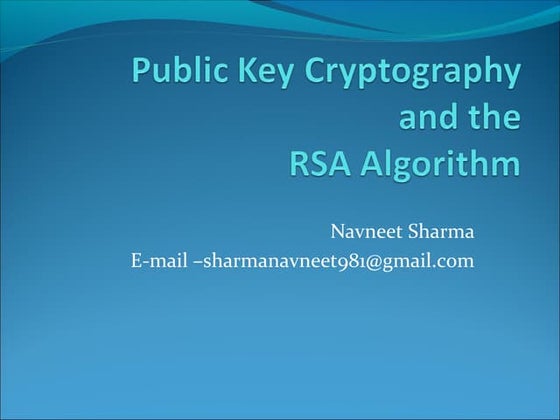



RsaNavneet Sharma
?
traditional private/secret/single key cryptography uses one key
Key is shared by both sender and receiver
if the key is disclosed communications are compromised
also known as symmetric, both parties are equal
hence does not protect sender from receiver forging a message & claiming is sent by sender
Rsa cryptosystem



Rsa cryptosystemAbhishek Gautam
?
Cryptography is the practice and study of techniques for conveying information security.
The goal of Cryptography is to allow the intended recipients of the message to receive the message securely.
The most famous algorithm used today is RSA algorithmCryptography and RSA algorithm



Cryptography and RSA algorithmSaifil Momin
?
Cryptography involves encryption and decryption of messages. Encryption scrambles a message using an algorithm and key, while decryption restores the original message. There are two main types: private key cryptography uses the same key for encryption and decryption, while public key cryptography uses separate keys - a public key to encrypt and a private key to decrypt. The RSA algorithm is an example of public key cryptography that is widely used for secure communication on the internet. It relies on the fact that multiplying two large prime numbers together is easy, but factoring their product into primes is very difficult.RSA - ENCRYPTION ALGORITHM CRYPTOGRAPHY



RSA - ENCRYPTION ALGORITHM CRYPTOGRAPHYQualcomm
?
This document discusses public key cryptography and the RSA encryption algorithm. It provides an overview of public key cryptography, how the RSA algorithm works using a public and private key pair, and some of its applications. The RSA algorithm is based on the difficulty of factoring large prime numbers and allows for secure communication without needing to share secret keys. Some advantages are convenience and enabling message authentication and non-repudiation using digital signatures, while disadvantages include slower performance and the need to authenticate public keys.Rsa



Rsaismaelhaider
?
Public Key Cryptography uses two keys - a public key that can encrypt messages and verify signatures, and a private key that can decrypt messages and create signatures. The RSA algorithm, the most widely used public key algorithm, is based on the mathematical difficulty of factoring large prime numbers. It works by having users generate a public/private key pair using two large prime numbers and performing modular exponentiation. The security of RSA relies on the fact that it is computationally infeasible to derive the private key from the public key and modulus.Rsa Crptosystem



Rsa CrptosystemAmlan Patel
?
This ppt contains description about data and information,cryptography and how information can be protected using RSA cryptosystem.Cryptography using rsa cryptosystem



Cryptography using rsa cryptosystemSamdish Arora
?
The presentation explains basis of cryptography using RSA cryptosystem.
The whole mathematics behind the algorithm has been explained.Public Key Cryptography and RSA algorithm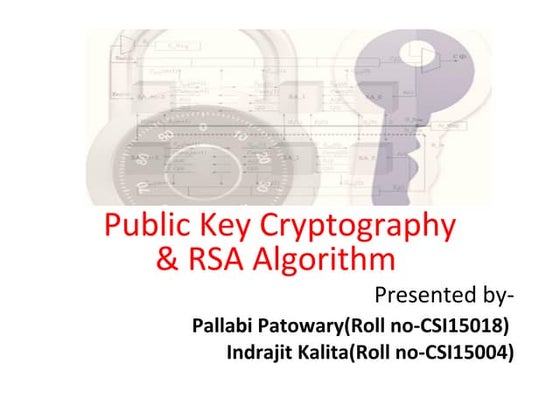



Public Key Cryptography and RSA algorithmIndra97065
?
Public Key Cryptography and RSA algorithm.Explanation and proof of RSA algorithm in details.it also describer the mathematics behind the RSA. Few mathematics theorem are given which are use in the RSA algorithm. RSA Algorithm - Public Key Cryptography



RSA Algorithm - Public Key CryptographyMd. Shafiul Alam Sagor
?
Public key cryptography uses two keys: a public key to encrypt messages and a private key to decrypt them. The RSA algorithm is based on the difficulty of factoring large prime numbers. It works by having users generate a public/private key pair and publishing their public key. To encrypt a message, the sender uses the recipient's public key. Only the recipient can decrypt with their private key. The security of RSA relies on the computational difficulty of factoring the modulus used to generate the keys.Information and data security public key cryptography and rsa



Information and data security public key cryptography and rsaMazin Alwaaly
?
Information And Data Security Public-Key Cryptography And RSA seminar
Mustansiriya University
Department of Education
Computer ScienceIntroduction to cryptography



Introduction to cryptographySuresh Thammishetty
?
Bob and Alice want to securely communicate messages between each other over an insecure channel. Cryptography allows them to encrypt messages using public key encryption so that only the intended recipient can decrypt it. The document discusses the basics of public key cryptography including how it works, the RSA algorithm, key generation process, and approaches to attacking public key cryptography like brute force attacks or mathematical attacks like integer factorization to derive the private key.Rsa and diffie hellman algorithms



Rsa and diffie hellman algorithmsdaxesh chauhan
?
The document provides an overview of RSA and Diffie-Hellman algorithms. It defines key terms in cryptography like plain text, cipher text, and key. It then describes how RSA works by choosing prime numbers, computing keys, and encrypting/decrypting messages. Diffie-Hellman allows two parties to establish a shared secret key over an insecure channel by agreeing on a modulus and base, and exchanging values while keeping their secret integers private.Computer Security Lecture 7: RSA



Computer Security Lecture 7: RSAMohamed Loey
?
We will discuss the following: RSA Key generation , RSA Encryption , RSA Decryption , A Real World Example, RSA Security.
https://www.youtube.com/watch?v=x7QWJ13dgGs&list=PLKYmvyjH53q13_6aS4VwgXU0Nb_4sjwuf&index=7Cryptography 



Cryptography pravin pandey
?
Cryptography involves encrypting messages to make them secure and immune to attacks. There are traditional ciphers like substitution and transposition ciphers that encrypt text by shifting letters or rearranging them. Modern algorithms like DES use symmetric keys and RSA uses public/private key pairs to encrypt and decrypt messages. Public key cryptography uses different public and private keys, allowing secure communication without pre-sharing keys. Digital signatures authenticate messages using the sender's private key and can be verified by anyone using their public key.RSA Algorithem and information about rsa



RSA Algorithem and information about rsaMohsin Ali
?
RSA was developed in 1977 by Ron Rivest, Adi Shamir and Leonard Adleman. It uses public and private key pairs to encrypt and decrypt messages. The security of RSA relies on the difficulty of factoring large prime numbers. It is commonly used for encryption and digital signatures in applications like SSL/TLS and SSH.RSA Algorithm



RSA Algorithmchauhankapil
?
This document describes the RSA algorithm for public key cryptography. RSA is based on the idea that factoring large integers into their prime factors is difficult. It involves choosing two prime numbers p and q, computing n=pq, and selecting a public key e such that gcd(e,(p-1)(q-1))=1. The private key d is computed such that ed=1 (mod ¦Õ(n)). To encrypt a message M, the sender computes C=Me (mod n) using the recipient's public key. The recipient decrypts by computing M=Cd (mod n) using their private key. The security of RSA relies on the difficulty of factoring the modulus n.RSA - ALGORITHM by Muthugomathy and Meenakshi Shetti of GIT COLLEGE 



RSA - ALGORITHM by Muthugomathy and Meenakshi Shetti of GIT COLLEGE Qualcomm
?
A nice animated presentation explaining the method of RSA algorithm.
Its definition, explanation, advantages, disadvantages.
RSA ALGORITHM



RSA ALGORITHMSathish Kumar
?
RSA is an asymmetric cryptographic algorithm used for encrypting and decrypting messages. It uses a public key for encryption and a private key for decryption such that a message encrypted with the public key can only be decrypted with the corresponding private key. The RSA algorithm involves three steps: key generation, encryption, and decryption. It addresses issues of key distribution and digital signatures.Ch9



Ch9Mahender Kumar
?
This document discusses public key cryptography and the RSA algorithm. It begins by outlining some misconceptions about public key encryption. It then provides an overview of the key concepts behind public key cryptosystems, including the use of public and private key pairs to enable encryption, digital signatures, and key exchange. The document goes on to provide detailed explanations of the RSA algorithm, including how it uses large prime numbers and modular arithmetic to encrypt and decrypt messages securely. It discusses the security of the RSA algorithm and analyzes approaches for attacking it, such as brute force key searching and mathematical attacks based on factoring the private key.RSA Algorithm



RSA AlgorithmJoon Young Park
?
This document discusses the RSA cryptosystem, including an overview of symmetric and asymmetric key algorithms, the founders of RSA, the RSA key generation algorithm in 5 steps, estimated times to crack RSA keys of different sizes, possible side-channel attacks on RSA, tutorials on implementing RSA, and references for further reading. It provides information on the basic concepts and implementation of the RSA cryptosystem.Rsa algorithm key generation 



Rsa algorithm key generation swarnapatil
?
RSAAlgorithm is the first public key algorithm discovered in 1978 by Ron Rivest, Adi Shamir and Len Adleman. It uses different but related keys for encryption and decryption. The RSA algorithm can be used for both public key encryption and digital signatures. It works by selecting two large prime numbers to calculate the public and private keys. The public key is used to encrypt data and the private key is used to decrypt it.Rsa rivest shamir adleman



Rsa rivest shamir adlemanHossain Md Shakhawat
?
RSA, Rivest Shamir Adleman, How RSA works, Prove of RSA, Attacks against RSA, Effectiveness of RSA, Analyze RSArsa-1



rsa-1aniruddh Tyagi
?
RSA is a widely used public-key cryptosystem. It works by generating a public and private key pair. The public key is used for encryption and digital signatures while the private key is used for decryption and signature verification. Key generation involves finding two prime numbers p and q, computing the modulus n as their product, and using these values to calculate the public and private exponents e and d respectively.RSA Algorithm report



RSA Algorithm reportMohamed Ramadan
?
This report to document the RSA code and how it works from encrypting certain message to how to decrypt it using general and private keys which will be generated in the given code.The rsa algorithm



The rsa algorithmKomal Singh
?
This document provides an overview of the RSA algorithm for public-key cryptography. It explains that RSA uses a public key and private key pair, with the public key used for encryption and the private key used for decryption. The security of RSA relies on the difficulty of factoring large prime numbers. It then provides details on how the RSA algorithm works, including choosing two large prime numbers to generate keys, encrypting and decrypting messages, and an example calculation. Potential attacks on RSA like brute force key searching and timing analysis are also summarized.public-key cryptography Shamir



public-key cryptography ShamirInformation Security Awareness Group
?
Public-key cryptography uses two different but mathematically related keys for encryption and decryption. This allows one key to be public for encryption while keeping the other key secret for decryption. The Diffie-Hellman key exchange protocol allows two parties to establish a shared secret key over an insecure channel without any preexisting secret information. The RSA cryptosystem is an example of a public-key cryptosystem based on the difficulty of factoring large prime numbers."Digital Signature Recognition using RSA Algorithm



Digital Signature Recognition using RSA AlgorithmVinayak Raja
?
The document provides an overview of the RSA public key encryption algorithm. It discusses how RSA uses a public key and private key pair, with the public key used to encrypt messages and the private key used to decrypt them. The security of RSA relies on the difficulty of factoring the product of two large prime numbers. The document outlines the RSA algorithm steps of key generation, encryption, and decryption. It also discusses RSA applications, standardization, speed, weaknesses, and history.Diffie-Hellman Key Exchange



Diffie-Hellman Key ExchangeG¨¹rkan YILDIRIM
?
The document summarizes the Diffie-Hellman key exchange algorithm. It was the first publicly announced asymmetric key algorithm described by Diffie and Hellman in 1976. It allows two parties that have no prior knowledge of each other to jointly establish a shared secret key over an insecure communications channel. This key can then be used to encrypt subsequent communications using a symmetric key cipher. The algorithm is limited to key exchange and does not perform any authentication itself.Rsa



Rsamagentie
?
Public key cryptography uses two keys - a public key that can encrypt messages but not decrypt them, and a private key that can decrypt messages but not encrypt them. The RSA algorithm is a commonly used public key cryptosystem. It works by having users generate a public/private key pair using large prime numbers, then messages can be encrypted with the public key and decrypted with the private key. The security of RSA relies on the difficulty of factoring large numbers.PUBLIC KEY & RSA.ppt



PUBLIC KEY & RSA.pptRizwanBasha12
?
Public key cryptography uses two keys - a public key that can be shared openly and a private key that is kept secret. The RSA algorithm, invented in 1977, is the most widely used public key cryptosystem. It uses a public and private key pair generated from two large prime numbers. The public key is used to encrypt messages, while the private key is used to decrypt messages. The security of RSA relies on the difficulty of factoring the product of the two primes.Ad
More Related Content
What's hot (20)
RSA Algorithm - Public Key Cryptography



RSA Algorithm - Public Key CryptographyMd. Shafiul Alam Sagor
?
Public key cryptography uses two keys: a public key to encrypt messages and a private key to decrypt them. The RSA algorithm is based on the difficulty of factoring large prime numbers. It works by having users generate a public/private key pair and publishing their public key. To encrypt a message, the sender uses the recipient's public key. Only the recipient can decrypt with their private key. The security of RSA relies on the computational difficulty of factoring the modulus used to generate the keys.Information and data security public key cryptography and rsa



Information and data security public key cryptography and rsaMazin Alwaaly
?
Information And Data Security Public-Key Cryptography And RSA seminar
Mustansiriya University
Department of Education
Computer ScienceIntroduction to cryptography



Introduction to cryptographySuresh Thammishetty
?
Bob and Alice want to securely communicate messages between each other over an insecure channel. Cryptography allows them to encrypt messages using public key encryption so that only the intended recipient can decrypt it. The document discusses the basics of public key cryptography including how it works, the RSA algorithm, key generation process, and approaches to attacking public key cryptography like brute force attacks or mathematical attacks like integer factorization to derive the private key.Rsa and diffie hellman algorithms



Rsa and diffie hellman algorithmsdaxesh chauhan
?
The document provides an overview of RSA and Diffie-Hellman algorithms. It defines key terms in cryptography like plain text, cipher text, and key. It then describes how RSA works by choosing prime numbers, computing keys, and encrypting/decrypting messages. Diffie-Hellman allows two parties to establish a shared secret key over an insecure channel by agreeing on a modulus and base, and exchanging values while keeping their secret integers private.Computer Security Lecture 7: RSA



Computer Security Lecture 7: RSAMohamed Loey
?
We will discuss the following: RSA Key generation , RSA Encryption , RSA Decryption , A Real World Example, RSA Security.
https://www.youtube.com/watch?v=x7QWJ13dgGs&list=PLKYmvyjH53q13_6aS4VwgXU0Nb_4sjwuf&index=7Cryptography 



Cryptography pravin pandey
?
Cryptography involves encrypting messages to make them secure and immune to attacks. There are traditional ciphers like substitution and transposition ciphers that encrypt text by shifting letters or rearranging them. Modern algorithms like DES use symmetric keys and RSA uses public/private key pairs to encrypt and decrypt messages. Public key cryptography uses different public and private keys, allowing secure communication without pre-sharing keys. Digital signatures authenticate messages using the sender's private key and can be verified by anyone using their public key.RSA Algorithem and information about rsa



RSA Algorithem and information about rsaMohsin Ali
?
RSA was developed in 1977 by Ron Rivest, Adi Shamir and Leonard Adleman. It uses public and private key pairs to encrypt and decrypt messages. The security of RSA relies on the difficulty of factoring large prime numbers. It is commonly used for encryption and digital signatures in applications like SSL/TLS and SSH.RSA Algorithm



RSA Algorithmchauhankapil
?
This document describes the RSA algorithm for public key cryptography. RSA is based on the idea that factoring large integers into their prime factors is difficult. It involves choosing two prime numbers p and q, computing n=pq, and selecting a public key e such that gcd(e,(p-1)(q-1))=1. The private key d is computed such that ed=1 (mod ¦Õ(n)). To encrypt a message M, the sender computes C=Me (mod n) using the recipient's public key. The recipient decrypts by computing M=Cd (mod n) using their private key. The security of RSA relies on the difficulty of factoring the modulus n.RSA - ALGORITHM by Muthugomathy and Meenakshi Shetti of GIT COLLEGE 



RSA - ALGORITHM by Muthugomathy and Meenakshi Shetti of GIT COLLEGE Qualcomm
?
A nice animated presentation explaining the method of RSA algorithm.
Its definition, explanation, advantages, disadvantages.
RSA ALGORITHM



RSA ALGORITHMSathish Kumar
?
RSA is an asymmetric cryptographic algorithm used for encrypting and decrypting messages. It uses a public key for encryption and a private key for decryption such that a message encrypted with the public key can only be decrypted with the corresponding private key. The RSA algorithm involves three steps: key generation, encryption, and decryption. It addresses issues of key distribution and digital signatures.Ch9



Ch9Mahender Kumar
?
This document discusses public key cryptography and the RSA algorithm. It begins by outlining some misconceptions about public key encryption. It then provides an overview of the key concepts behind public key cryptosystems, including the use of public and private key pairs to enable encryption, digital signatures, and key exchange. The document goes on to provide detailed explanations of the RSA algorithm, including how it uses large prime numbers and modular arithmetic to encrypt and decrypt messages securely. It discusses the security of the RSA algorithm and analyzes approaches for attacking it, such as brute force key searching and mathematical attacks based on factoring the private key.RSA Algorithm



RSA AlgorithmJoon Young Park
?
This document discusses the RSA cryptosystem, including an overview of symmetric and asymmetric key algorithms, the founders of RSA, the RSA key generation algorithm in 5 steps, estimated times to crack RSA keys of different sizes, possible side-channel attacks on RSA, tutorials on implementing RSA, and references for further reading. It provides information on the basic concepts and implementation of the RSA cryptosystem.Rsa algorithm key generation 



Rsa algorithm key generation swarnapatil
?
RSAAlgorithm is the first public key algorithm discovered in 1978 by Ron Rivest, Adi Shamir and Len Adleman. It uses different but related keys for encryption and decryption. The RSA algorithm can be used for both public key encryption and digital signatures. It works by selecting two large prime numbers to calculate the public and private keys. The public key is used to encrypt data and the private key is used to decrypt it.Rsa rivest shamir adleman



Rsa rivest shamir adlemanHossain Md Shakhawat
?
RSA, Rivest Shamir Adleman, How RSA works, Prove of RSA, Attacks against RSA, Effectiveness of RSA, Analyze RSArsa-1



rsa-1aniruddh Tyagi
?
RSA is a widely used public-key cryptosystem. It works by generating a public and private key pair. The public key is used for encryption and digital signatures while the private key is used for decryption and signature verification. Key generation involves finding two prime numbers p and q, computing the modulus n as their product, and using these values to calculate the public and private exponents e and d respectively.RSA Algorithm report



RSA Algorithm reportMohamed Ramadan
?
This report to document the RSA code and how it works from encrypting certain message to how to decrypt it using general and private keys which will be generated in the given code.The rsa algorithm



The rsa algorithmKomal Singh
?
This document provides an overview of the RSA algorithm for public-key cryptography. It explains that RSA uses a public key and private key pair, with the public key used for encryption and the private key used for decryption. The security of RSA relies on the difficulty of factoring large prime numbers. It then provides details on how the RSA algorithm works, including choosing two large prime numbers to generate keys, encrypting and decrypting messages, and an example calculation. Potential attacks on RSA like brute force key searching and timing analysis are also summarized.public-key cryptography Shamir



public-key cryptography ShamirInformation Security Awareness Group
?
Public-key cryptography uses two different but mathematically related keys for encryption and decryption. This allows one key to be public for encryption while keeping the other key secret for decryption. The Diffie-Hellman key exchange protocol allows two parties to establish a shared secret key over an insecure channel without any preexisting secret information. The RSA cryptosystem is an example of a public-key cryptosystem based on the difficulty of factoring large prime numbers."Digital Signature Recognition using RSA Algorithm



Digital Signature Recognition using RSA AlgorithmVinayak Raja
?
The document provides an overview of the RSA public key encryption algorithm. It discusses how RSA uses a public key and private key pair, with the public key used to encrypt messages and the private key used to decrypt them. The security of RSA relies on the difficulty of factoring the product of two large prime numbers. The document outlines the RSA algorithm steps of key generation, encryption, and decryption. It also discusses RSA applications, standardization, speed, weaknesses, and history.Diffie-Hellman Key Exchange



Diffie-Hellman Key ExchangeG¨¹rkan YILDIRIM
?
The document summarizes the Diffie-Hellman key exchange algorithm. It was the first publicly announced asymmetric key algorithm described by Diffie and Hellman in 1976. It allows two parties that have no prior knowledge of each other to jointly establish a shared secret key over an insecure communications channel. This key can then be used to encrypt subsequent communications using a symmetric key cipher. The algorithm is limited to key exchange and does not perform any authentication itself.Similar to 3 pkc+rsa (20)
Rsa



Rsamagentie
?
Public key cryptography uses two keys - a public key that can encrypt messages but not decrypt them, and a private key that can decrypt messages but not encrypt them. The RSA algorithm is a commonly used public key cryptosystem. It works by having users generate a public/private key pair using large prime numbers, then messages can be encrypted with the public key and decrypted with the private key. The security of RSA relies on the difficulty of factoring large numbers.PUBLIC KEY & RSA.ppt



PUBLIC KEY & RSA.pptRizwanBasha12
?
Public key cryptography uses two keys - a public key that can be shared openly and a private key that is kept secret. The RSA algorithm, invented in 1977, is the most widely used public key cryptosystem. It uses a public and private key pair generated from two large prime numbers. The public key is used to encrypt messages, while the private key is used to decrypt messages. The security of RSA relies on the difficulty of factoring the product of the two primes.CNS.ppt



CNS.pptGopinathSamydurai
?
Public-key cryptography uses two keys: a public key that can encrypt messages but not decrypt them, and a private key that can decrypt messages but not encrypt them. RSA is a widely used public-key cryptosystem that relies on the difficulty of factoring large prime numbers. It works by having users generate a public/private key pair using prime numbers, then allows encryption with the public key and decryption with the private key. The security of RSA depends on the computational difficulty of factoring the modulus used or determining the private key by other means.Ch09



Ch09Joe Christensen
?
Public-key cryptography uses two keys: a public key that can encrypt messages and verify signatures, and a private key that can decrypt messages and create signatures. The RSA algorithm is widely used for public-key cryptography. It works by using large prime numbers to generate the public and private keys, such that it is easy to encrypt with the public key but computationally infeasible to derive the private key and decrypt without knowing the prime numbers. The security of RSA relies on the difficulty of factoring the product of the large prime numbers. Timing attacks aim to break RSA security by analyzing variations in computation times, but countermeasures can prevent leaks of private information.Unit --3.ppt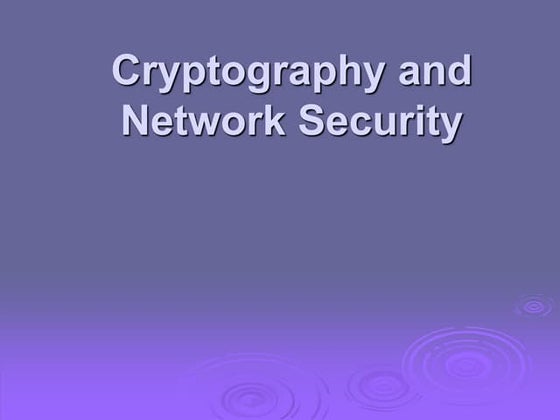



Unit --3.pptDHANABALSUBRAMANIAN
?
Public-key cryptography uses two keys: a public key to encrypt messages and verify signatures, and a private key for decryption and signing. RSA is the most widely used public-key cryptosystem, using large prime factorization and exponentiation modulo n for encryption and decryption. While faster than brute-force, breaking RSA remains computationally infeasible with sufficiently large key sizes over 1024 bits.ch09_rsa_nemo.ppt



ch09_rsa_nemo.pptChandraB15
?
Public-key cryptography uses two keys: a public key for encryption and digital signatures, and a private key for decryption and signature verification. RSA is the most widely used public-key cryptosystem, using large prime factorization and modular exponentiation. It allows secure communication without prior key exchange. While brute force attacks on RSA are infeasible due to large key sizes, its security relies on the difficulty of factoring large numbers.Unit-III_3R-CRYPTO_2021-22_VSM.pptx



Unit-III_3R-CRYPTO_2021-22_VSM.pptxVishwanathMahalle
?
This document discusses public-key cryptography and digital signatures. It begins with an introduction to symmetric and asymmetric key cryptography, including the basic concepts and differences between the two approaches. It then provides more details on public-key cryptography principles, including how public/private key pairs are generated and used. The document explains the RSA algorithm for public-key encryption and decryption in detail with examples. It also covers digital signature models and how they provide message authentication, integrity, and non-repudiation using public-key techniques. Diffie-Hellman key exchange is introduced as a method for securely transmitting a symmetric secret key between two parties.RSA



RSAAbirami Thangavel
?
This document discusses public key cryptography and the RSA algorithm. It begins by explaining the limitations of private key cryptography and how public key cryptography addresses issues like key distribution and digital signatures. It then describes how RSA works, using two keys - a public key for encryption and a private key for decryption. It explains the key generation process, how messages are encrypted and decrypted, and discusses the mathematical principles and security of the RSA algorithm.RSA Algm.pptx



RSA Algm.pptxSou Jana
?
Public key cryptography uses two keys - a public key for encryption and a private key for decryption. The RSA algorithm is a widely used public key cryptosystem that is based on the difficulty of factoring large prime numbers. It uses a public key for encryption and a related private key for decryption. The security of RSA relies on the fact that it is computationally infeasible to determine the private key from the public key for sufficiently large key sizes.Information and network security 33 rsa algorithm



Information and network security 33 rsa algorithmVaibhav Khanna
?
RSA algorithm is asymmetric cryptography algorithm. Asymmetric actually means that it works on two different keys i.e. Public Key and Private Key. As the name describes that the Public Key is given to everyone and Private key is kept privatePooguzhali



PooguzhaliNIVEDHINIMANIVANNAN
?
This document discusses public key cryptography and the RSA algorithm. It provides explanations of public key encryption including its key components like plaintext, encryption algorithm, public and private keys, and decryption algorithm. It then describes the conventional encryption method versus public key encryption. Finally, it explains the RSA algorithm in detail, including how it generates key pairs, how encryption and decryption works using the keys, and some of the mathematical concepts that make RSA secure like the difficulty of factoring large numbers.international security system data threats



international security system data threatsgacop74666
?
1. Principle of Least Privilege (POLP) This principle states that every user and program on the system should be granted only the specific rights and permissions needed to perform their tasks, with no more.PRINCIPLES OF INFORMATION SYSTEM SECURITY



PRINCIPLES OF INFORMATION SYSTEM SECURITYgacop74666
?
Introduction: Information security is more and more important every day in the workplace. If we want to improve our information security, we need a solid understanding of the principles that will help us do that. This guide explores those principles and will guide you to building a more secure environment.
Information Security Principles: There are three basic principles of information security, and all other practices are based on these three:
* Confidentiality: Confidentiality is the basic tenet of information security. Confidentiality means that you don't share private or confidential information with anyone who shouldn't know it. As the name implies, you don't give out confidential information.
* Availability: Availability means that you can access the information you need when you need it. You may not need access to everything all the time, but when you do, you want access quickly. You may need access to your bank account when you pay a bill. This is availability.
* Integrity: If you make a change to something, it should be tracked and logged in a journal or log. That way, you can verify that no unauthorized changes were made to the original information, so we know that the information is genuine. In short, integrity means you can verify that the information hasn't been altered in any way.
There are four key concepts that underpin the practice of information security. These concepts, when integrated and applied appropriately, enable security managers and practitioners to defend against and recover from attacks. The four key concepts are:
* Confidentiality: Confidentiality refers to protecting information from unauthorized access, use, or disclosure. This includes both internal and external threats. Data encryption or access control lists are examples of confidentiality controls.
* Integrity: Integrity refers to protecting the accuracy, completeness, and validity of information. This includes protecting data from being modified without authorization. Data hashing algorithms or message authentication codes are examples of integrity controls.
* Availability: Availability refers to ensuring that information and systems are accessible to authorized users when they need them. This includes measures to prevent service outages or data loss due to natural disasters or accidental or intentional malicious activity. Redundant systems, data backups, and disaster recovery plans are examples of availability controls.
* Accountability: Accountability involves tracing user actions to the identity of the user. If the user's identity is associated with a group, then the actions of the user are also associated with the group. Accountability mechanisms typically involve the use of logs, audit trails, and other monitoring techniques. Accountability controls are also used to identify and fix system weaknesses that could lead to unauthorized access or changes to data and systems.
By following these basic principles, we can help protect our information froPublic-Key Cryptography.pdfWrite the result of the following operation with t...



Public-Key Cryptography.pdfWrite the result of the following operation with t...FahmiOlayah
?
Write the result of the following operation with the correct number of significant figure of 0.248?Write the result of the following operation with the correct number of signiPKC&RSA



PKC&RSAAnver S R
?
This document discusses public key cryptography and the RSA algorithm. It begins by explaining the differences between symmetric and asymmetric cryptosystems. It then describes the key components of public key cryptography, including public/private key pairs, certificates, and algorithms. The document goes on to explain the mathematical foundations of public key cryptography using concepts like Euler's totient function and the discrete logarithm problem. It provides details on the RSA algorithm, including key generation, encryption, and decryption. It also includes an example of RSA encryption and decryption. Finally, it discusses some attacks on RSA like brute force and timing attacks, as well as countermeasures.RSA



RSAbansidhar11
?
This document provides a summary of public key encryption and digital signatures. It begins by reviewing symmetric cryptography and its limitations in key distribution. It then introduces public key encryption, where each party has a public and private key pair. The document outlines the RSA algorithm and how it uses large prime number factorization problems to encrypt and decrypt messages. It also discusses how digital signatures can provide authentication, integrity, and non-repudiation for electronic messages and contracts using public key techniques like RSA.Rivest Shamir Adleman Algorithm and its variant : DRSA.pptx



Rivest Shamir Adleman Algorithm and its variant : DRSA.pptxwerip98386
?
The document summarizes the RSA cryptosystem. It begins with an introduction to cryptography and the two types: symmetric and asymmetric. RSA is an asymmetric algorithm that uses a public and private key pair. The document provides an illustration of how RSA works and describes the key generation process where two prime numbers are multiplied to generate the modulus and keys. It also provides an example of encrypting a plaintext message using a public key and decrypting the ciphertext with a private key. Advantages of RSA include security while disadvantages are slower speed and large key sizes.Ad
Recently uploaded (20)
22PCOAM16 Unit 3 Session 23 Different ways to Combine Classifiers.pptx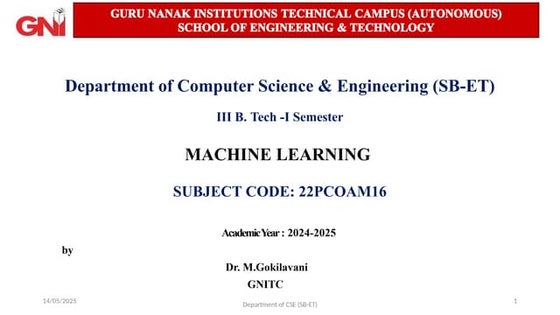



22PCOAM16 Unit 3 Session 23 Different ways to Combine Classifiers.pptxGuru Nanak Technical Institutions
?
22PCOAM16 Unit 3 Session 23 Different ways to Combine Classifiers. pptxUnleashing the Power of Salesforce Flows &_ Slack Integration!.pptx



Unleashing the Power of Salesforce Flows &_ Slack Integration!.pptxSanjeetMishra29
?
Unleashing the Power of Salesforce Flows &_ Slack Integration!.pptxDesign Optimization of Reinforced Concrete Waffle Slab Using Genetic Algorithm



Design Optimization of Reinforced Concrete Waffle Slab Using Genetic AlgorithmJournal of Soft Computing in Civil Engineering
?
This research presents the optimization techniques for reinforced concrete waffle slab design because the EC2 code cannot provide an efficient and optimum design. Waffle slab is mostly used where there is necessity to avoid column interfering the spaces or for a slab with large span or as an aesthetic purpose. Design optimization has been carried out here with MATLAB, using genetic algorithm. The objective function include the overall cost of reinforcement, concrete and formwork while the variables comprise of the depth of the rib including the topping thickness, rib width, and ribs spacing. The optimization constraints are the minimum and maximum areas of steel, flexural moment capacity, shear capacity and the geometry. The optimized cost and slab dimensions are obtained through genetic algorithm in MATLAB. The optimum steel ratio is 2.2% with minimum slab dimensions. The outcomes indicate that the design of reinforced concrete waffle slabs can be effectively carried out using the optimization process of genetic algorithm.AI Chatbots & Software Development Teams



AI Chatbots & Software Development TeamsJoe Krall
?
Welcome to MIND UP: a special presentation for Cloudvirga, a Stewart Title company. In this session, we¡¯ll explore how you can ¡°mind up¡± and unlock your potential by using generative AI chatbot tools at work.
Curious about the rise of AI chatbots? Unsure how to use them-or how to use them safely and effectively in your workplace? You¡¯re not alone. This presentation will walk you through the practical benefits of generative AI chatbots, highlight best practices for safe and responsible use, and show how these tools can help boost your productivity, streamline tasks, and enhance your workday.
Whether you¡¯re new to AI or looking to take your skills to the next level, you¡¯ll find actionable insights to help you and your team make the most of these powerful tools-while keeping security, compliance, and employee well-being front and center.Python Functions, Modules and Packages



Python Functions, Modules and PackagesDr. A. B. Shinde
?
The detailed study on Python Functions, modules and Packages are discussed hereIPC-7711D-7721D_ EN 2023 TOC Rework, Modification and Repair of Electronic As...



IPC-7711D-7721D_ EN 2023 TOC Rework, Modification and Repair of Electronic As...ssuserd9338b
?
IPC-7711D-7721D_ EN 2023 TOC Rework, Modification and Repair of Electronic Assemblies.pdfConstruction Materials (Paints) in Civil Engineering



Construction Materials (Paints) in Civil EngineeringLavish Kashyap
?
This file will provide you information about various types of Paints in Civil Engineering field under Construction Materials.
It will be very useful for all Civil Engineering students who wants to search about various Construction Materials used in Civil Engineering field.
Paint is a vital construction material used for protecting surfaces and enhancing the aesthetic appeal of buildings and structures. It consists of several components, including pigments (for color), binders (to hold the pigment together), solvents or thinners (to adjust viscosity), and additives (to improve properties like durability and drying time).
Paint is one of the material used in Civil Engineering field. It is especially used in final stages of construction project.
Paint plays a dual role in construction: it protects building materials and contributes to the overall appearance and ambiance of a space.GROUP 2 - MANUFACTURE OF LIME, GYPSUM AND CEMENT.pdf



GROUP 2 - MANUFACTURE OF LIME, GYPSUM AND CEMENT.pdfkemimafe11
?
Lime, Gypsum and cement manufacturing process, Application in real life Automatic Quality Assessment for Speech and Beyond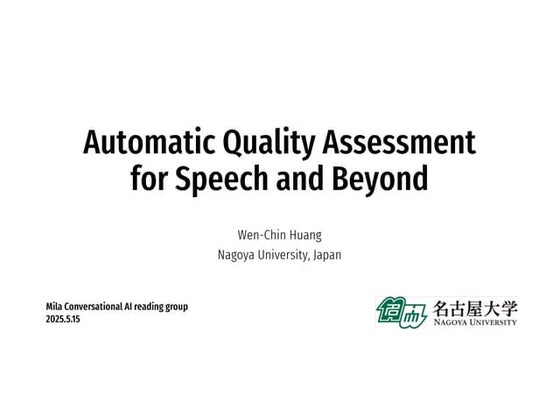



Automatic Quality Assessment for Speech and BeyondNU_I_TODALAB
?
Mila Conversational AI reading group
Wen-Chin Huang£ºAutomatic Quality Assessment for Speech and Beyond£¬May 2025
Ãû¹ÅÎİ´óѧ ÇéˆóѧÑо¿¿Æ ÖªÄÜ¥·¥¹¥Æ¥àѧŒŸ¹¥ ‘õÌïÑо¿ÊÒVISHAL KUMAR SINGH Latest Resume with updated details



VISHAL KUMAR SINGH Latest Resume with updated detailsVishal Kumar Singh
?
VISHAL KUMAR SINGH Latest Resume with updated details860556374-10280271.pptx PETROLEUM COKE CALCINATION PLANT



860556374-10280271.pptx PETROLEUM COKE CALCINATION PLANTPierre Celestin Eyock
?
Project description of petroleum coke calcination plantDavid Boutry - Specializes In AWS, Microservices And Python



David Boutry - Specializes In AWS, Microservices And PythonDavid Boutry
?
With over eight years of experience, David Boutry specializes in AWS, microservices, and Python. As a Senior Software Engineer in New York, he spearheaded initiatives that reduced data processing times by 40%. His prior work in Seattle focused on optimizing e-commerce platforms, leading to a 25% sales increase. David is committed to mentoring junior developers and supporting nonprofit organizations through coding workshops and software development.Espresso PD Official MP_eng Version.pptx



Espresso PD Official MP_eng Version.pptxNingChacha1
?
Cosmetic standards in manufacturing play a crucial role in ensuring the visual quality of products meets customer expectations while maintaining functional integrity. In industries such as electronics, automotive, and consumer goods, cosmetic defects¡ªthough often non-functional¡ªcan impact brand perception, product desirability, and customer satisfaction.
### **Introduction to Cosmetic Standards in Manufacturing**
Cosmetic standards refer to the guidelines set by manufacturers to evaluate the appearance of a product. These guidelines define acceptable and unacceptable visual defects, ensuring products present a clean, professional look. While minor imperfections may be permissible, consistent and visible defects can lead to customer complaints or reduced marketability.
### **Key Cosmetic Defects in Manufacturing**
Manufacturing processes can introduce various cosmetic defects, including:
- **Scratches and Scuffs**: Surface-level marks that occur during handling, assembly, or packaging.
- **Dents and Deformations**: Physical damage to materials due to improper handling or tooling issues.
- **Color Variations**: Differences in shading or texture due to material inconsistencies or environmental factors during production.
- **Molding Defects**: Injection molding processes can introduce flow lines, sink marks, or flash, affecting the visual quality of plastic components.
- **Print and Label Imperfections**: Misaligned text, smudging, or incomplete printing can impact branding and identification.
- **Paint or Coating Defects**: Issues such as peeling, chipping, or uneven application affecting surface finish.
- **Contaminations and Foreign Material**: Dust, hair, or other particles embedded in the product can be perceived as poor workmanship.
### **Defining Cosmetic Acceptance Criteria**
Manufacturers typically establish cosmetic acceptance criteria based on industry standards, customer expectations, and internal quality requirements. These criteria specify:
- **Defect Classification**: Minor, major, or critical defects based on impact on functionality and aesthetics.
- **Inspection Methods**: Visual inspection under controlled lighting conditions and specific angles.
- **Measurement Tools**: Rulers, calipers, or digital inspection systems for consistency in defect evaluation.
- **Pass/Fail Guidelines**: Clear thresholds for acceptable and non-acceptable defects.
### **Inspection and Quality Control Methods**
To enforce cosmetic standards, manufacturers implement stringent inspection processes, including:
- **Automated Vision Systems**: Using AI-powered cameras to detect surface irregularities.
- **Manual Inspection**: Trained personnel evaluating each unit based on predefined standards.
- **Sampling Plans**: Statistical methods such as AQL (Acceptable Quality Limit) to ensure representative evaluation.
- **Defect Tagging and Sorting**: Classifying defective units for rework, scrapping, or customer review.
Domain1_Security_Principles --(My_Notes)



Domain1_Security_Principles --(My_Notes)efs14135
?
Notes on Security Principles from the IC2 CC course22PCOAM16 Unit 3 Session 23 Different ways to Combine Classifiers.pptx



22PCOAM16 Unit 3 Session 23 Different ways to Combine Classifiers.pptxGuru Nanak Technical Institutions
?
Design Optimization of Reinforced Concrete Waffle Slab Using Genetic Algorithm



Design Optimization of Reinforced Concrete Waffle Slab Using Genetic AlgorithmJournal of Soft Computing in Civil Engineering
?
Ad
3 pkc+rsa
- 2. 2 Private-Key Cryptography ? traditional private/secret/single key cryptography uses one key ? shared by both sender and receiver ? if this key is disclosed communications are compromised ? also is symmetric, parties are equal ? hence does not protect sender from receiver forging a message & claiming it is sent by sender
- 3. 3 Public-Key Cryptography ? public-key/two-key/asymmetric cryptography involves the use of two keys: ¨C a public-key, which may be known by anybody, and can be used to encrypt messages, and verify signatures ¨C a private-key, known only to the recipient, used to decrypt messages, and sign (create) signatures ? is asymmetric because ¨C those who encrypt messages or verify signatures cannot decrypt messages or create signatures
- 4. Asymmetric key cryptography uses two separate keys: one private and one public. 10.4 Asymmetric key cryptography Locking and unlocking in asymmetric-key cryptosystem
- 5. 10.5 10.1.2 General Idea Figure 10.2 General idea of asymmetric-key cryptosystem
- 6. 6 Why Public-Key Cryptography? ? developed to address two key issues: ¨C key distribution ¨C how to have secure communications in general without having to trust a KDC with your key ¨C digital signatures ¨C how to verify a message comes intact from the claimed sender
- 7. 7 Public-Key Characteristics ? Public-Key algorithms rely on two keys where: ¨C it is computationally infeasible to find decryption key knowing only algorithm & encryption key ¨C it is computationally easy to en/decrypt messages when the relevant (en/decrypt) key is known ¨C either of the two related keys can be used for encryption, with the other used for decryption (for some algorithms)
- 8. 8 Public-Key Applications ? can classify uses into 3 categories: ¨C encryption/decryption (provide secrecy) ¨C digital signatures (provide authentication) ¨C key exchange (of session keys) ? some algorithms are suitable for all uses, others are specific to one
- 9. Symmetric-key cryptography is based on sharing secrecy; asymmetric-key cryptography is based on personal secrecy. 10.9 Note
- 10. Plaintext/Ciphertext Unlike in symmetric-key cryptography(symbols permuted or substituted), plaintext and cipher text are treated as integers in asymmetric-key cryptography. Encryption/Decryption 10.10 Continued C = f (Kpublic , P) P = g(Kprivate , C)
- 11. The main idea behind asymmetric-key cryptography is the concept of the trapdoor one-way function. 10.11 10.1.4 Trapdoor One-Way Function Functions Figure 10.3 A function as rule mapping a domain to a range
- 12. Trapdoor One-Way Function (TOWF) 10.12 10.1.4 Continued One-Way Function (OWF) 1. f is easy to compute. 2. f ?1 is difficult to compute. 3. Given y and a trapdoor, x can be computed easily.
- 13. 10.13 10.1.4 Continued Example 10. 1 When n is large, n = p ¡Á q is a one-way function. Given p and q , it is always easy to calculate n ; given n, it is very difficult to compute p and q. This is the factorization problem.
- 14. 14 RSA ? By Rivest, Shamir & Adleman of MIT in 1977 ? best known & widely used public-key scheme ? based on exponentiation in a finite field over integers modulo a prime. ? uses large integers (e.g., 1024 bits) ? security due to cost of factoring large numbers
- 15. 15 RSA Key Setup ? each user generates a public/private key pair by: ? selecting two large primes at random - p,q ? computing their system modulus n=p.q -define ?(n)=(p-1)(q-1) ? selecting at random the encryption key e ? where 1<e<?(n), gcd(e,?(n))=1 ? solve following equation to find decryption key d ¨C e.d=1 mod ?(n) and 0¡Üd¡Ün ? publish their public encryption key: PU={e,n} ? keep secret private decryption key: PR={d,n}
- 16. 16 RSA Use ? to encrypt a message M the sender: ¨C obtains public key of recipient PU={e,n} ¨C computes: C = Me mod n, where 0¡ÜM<n ? to decrypt the ciphertext C the owner: ¨C uses their private key PR={d,n} ¨C computes: M = Cd mod n ? note that the message M must be smaller than the modulus n (block if needed)
- 17. 17 RSA Example - Key Setup 1. Select primes: p=17 & q=11 2. Compute n = pq =17 x 11=187 3. Compute ?(n)=(p¨C1)(q-1)=16 x 10=160 4. Select e: gcd(e,160)=1; choose e=7 5. Determine d: de=1 mod 160 and d < 160 Value is d=23 since 23x7=161= 10x160+1 6. Publish public key PU={7,187} 7. Keep secret private key PR={23,187}
- 18. 18 RSA Example - En/Decryption ? sample RSA encryption/decryption is: ? given message M = 88 ? encryption: C = 887 mod 187 = 11 ? decryption: M = 1123 mod 187 = 88
- 19. 19 RSA Key Generation ? users of RSA must: ¨C determine two primes at random - p, q ¨C select either e or d and compute the other ? primes p,q must not be easily derived from modulus n=p.q ¨C means must be sufficiently large ¨C typically guess and use probabilistic test ? exponents e, d are inverses, so use Inverse algorithm to compute the other
- 20. 20 RSA Security ? possible approaches to attacking RSA are: ¨C brute force key search (infeasible given size of numbers) ¨C mathematical attacks (based on difficulty of computing ?(n), by factoring modulus n) ¨C chosen ciphertext attacks (given properties of RSA)
- 21. 21 Factoring Problem ? mathematical approach takes 3 forms: ¨C factor n=p.q, hence compute ?(n) and then d ¨C determine ?(n) directly and compute d ¨C find d directly ? currently assume 1024-2048 bit RSA is secure
- 22. ? Broadcast attack: If an entity sends the same message with same encryption coe.(e) to different recipients (moduli being n1,n2,n3) ? Let e=3 then, ? C1=P3mod n1 ? C2=P3mod n2 ? C3=P3mod n3 ? Apply the Chinese Remainder Theorem to the 3 eqns. C¡¯=P3mod (n1n2n3) ? P3< n1n2n3. ? C¡¯=P3. Hence get P
- 23. 23 Timing Attacks ? developed by Paul Kocher in mid-1990¡¯s ? cipher text only attack. ? Based on fast exponential algorithm.(guessing d from Cd mod p) ? exploit timing variations in operations ? infer operand size based on the time taken by the decrypting algorithm. ? Counter measures ¨C use constant exponentiation time. ¨C add random delays.
- 24. Chosen Cipher text Attacks ? based on the multiplicative property of RSA. ? attackers chooses cipher texts & gets decrypted plaintext back. ? assume that intruder intercepts C=Pe mod n. ? Intruder chooses a random integer X in Zn*. Calculate Y=C x Xe mod n ? He sends Y to Bob for decryption and get Z=Ydmod n. ? With this intruder can find P easily. 24








